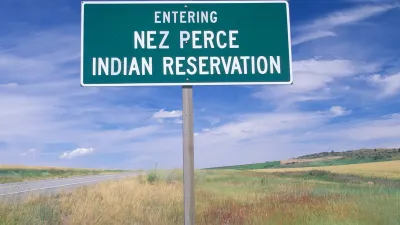Planners' activities in a community have a direct impact on its character, says Edward Jepson, and can be pivotal in creating sustainability.
Communities are the lynchpins of sustainability.
There are several reasons for this. For one thing, it is at this level that the individual natural processes occur that together comprise and create the environment; i.e., the contamination of a lake can be traced to the contamination of its streams. Second, it is at this level where signals – information about the environmental, social and economic conditions – are most clear, thus making it easier to understand what's happening and what needs to be done. Third, local residents are most directly affected and therefore more likely to be personally committed to the taking of determined action.
Of course, determined action is not necessarily appropriate action. To help ensure that appropriate action is taken, it is important that local residents have an understanding of the systemic dynamics under which they are functioning. Communities are systems just like any other system in nature and have the same interactive dynamics.
First, the human system is lower in the hierarchy than the natural system. This means that the ultimate control is from it to us. This control can either be accepted – by developing sustainably – or imposed, as a result of resource depletion and environmental contamination.
Second, communities are the lowest level of authority in the U.S. political system hierarchy. As such, state and other supra-local jurisdictions fulfill a higher-order systemic function when they act to restrain the behavior of communities. The level and nature of that restraint is determined through communication between the two systems.
Third, systemic stability is the result of people, communities, and organizations understanding their mutual inter-dependencies and the need to work together.
Fourth, there is an inherent unpredictability in terms of the consequences of every action taken (or not taken) which makes it necessary to proceed thoughtfully and with caution.
A sustainable community will have values that are consistent with these controlling dynamics. First, it will have a bio-regional perspective, which is concerned with maintaining the integrity of the eco-space – the natural resources and processes – in which the community is embedded. Inequity and injustice – obstacles to cooperative behavior – are understood to be threats to the integrity of the system. Because environmental systems and social inequities transcend political and functional boundaries, there is a commitment to inter-governmental cooperation. Reduced dependence on imported resources and capacities is recognized as a way to increase local stability. The ability to adapt and change with conditions is understood to be an essential organizational quality. And there is a commitment to planning and other decision making processes that are well-informed in nature and diverse and broad-based in terms of participation.

These characteristics can be viewed as comprising the character of a sustainable community, when character is understood to mean "the complex of mental and ethical traits marking and often individualizing a person, group, or nation" (Merriam-Webster). Planners' activities in a community have a direct impact on its character; in fact, the roles they play and the planning processes they administer and manage are inherently character-building. The building of a sustainable community character depends on planners making a specific type of contribution in terms of education, mediation, mobilization, and adaptation.
Education in sustainable planning derives partly from the planner embracing his or her role as an advocate for sustainable approaches to planning and policy. To encourage the adoption of such approaches by the community, the planner explains the reasons behind his or her advocacy as part of a process of "mutual learning" (Friedman 1973). Whether or not the community agrees or not, the planner's efforts will still have made an educative – and character-building – contribution.
A community moving toward sustainability will inevitably experience conflicts. These have been characterized as three types: resource (use value versus intrinsic value), development (social needs versus environmental needs) and property (land for private wealth versus land for public welfare) (Campbell 1996). Planners with effective mediation skills – the ability to find shared interests among seemingly competing or contradictory positions – can help communities resolve these very fundamental conflicts and find acceptable bases for common action (Innes and Booher 2004).
The pluralistic nature of local politics makes the mobilization of groups and individuals an essential requirement. Non-government organizations (NGOs) serve as counter-balances to growth advocates and planners should actively and strategically recruit them for participation in planning and other decision making processes. When this recruitment is combined with broad-based citizen involvement, a crucial requirement of sustainability – the involvement of diverse agents – will have been satisfied.
Finally, a community's adaptability depends upon its ability to effectively process – that is, collect and act upon – information. Relative to this, it is important for planners to lead in the design of indicators that accurately measure the status of the community relative to its social conditions, use of resources, and effect on nature and the environment. To maintain the integrity of the information flow, planners should anticipate, expose and counter distortions and misrepresentations in the public dialogue (Forester 1982). They should also try to take advantage of the inherent "slack" in the local political system to help it break out of its "box" and move in new directions. As explained by Krumholz and Forester (1990), this involves meeting with elected officials, building internal (i.e., within the governmental system) alliances, and appealing directly to the public.
Planning for sustainable development requires that planners draw from their full repertoire of professional roles to further a vision of community based on its reality as a system. Their success in these roles will help their communities build a sustainable character which in turn will lead to better policies and programs.
Edward J. Jepson, Jr., Ph.D., AICP is a planning researcher and consultant in Knoxville, Tennessee.
References:
Campbell, S. 1996. Green cities, growing cities, just cities? Journal of the American Planning Association 62, 3: 296-312.
Forester, J. 1982. Planning in the face of power. Journal of the American Planning Association 48, 1: 67-80.
Friedman, J. 1973. Retracking America: A theory of transactive planning. Garden City, NY: Anchor Press/Doubleday.
Innes, J. E. and D. E. Booher. 2004. Reframing public participation: Strategies for the 21st century. Planning Theory and Practice 5, 4: 419-436.
Krumholz, N. and J. Forester. 1990. Making equity planning work. Philadelphia: Temple University Press.
Excerpted and adapted with permission from "Planning and sustainability" in Urban Planning in the 21st Century, pages 103- 116, copyright 2009 Nova Science Publishers, D.S. Graber and K. A. Birmingham, editors.

Alabama: Trump Terminates Settlements for Black Communities Harmed By Raw Sewage
Trump deemed the landmark civil rights agreement “illegal DEI and environmental justice policy.”

Planetizen Federal Action Tracker
A weekly monitor of how Trump’s orders and actions are impacting planners and planning in America.

The 120 Year Old Tiny Home Villages That Sheltered San Francisco’s Earthquake Refugees
More than a century ago, San Francisco mobilized to house thousands of residents displaced by the 1906 earthquake. Could their strategy offer a model for the present?

Indy Neighborhood Group Builds Temporary Multi-Use Path
Community members, aided in part by funding from the city, repurposed a vehicle lane to create a protected bike and pedestrian path for the summer season.

Congestion Pricing Drops Holland Tunnel Delays by 65 Percent
New York City’s contentious tolling program has yielded improved traffic and roughly $100 million in revenue for the MTA.

In Both Crashes and Crime, Public Transportation is Far Safer than Driving
Contrary to popular assumptions, public transportation has far lower crash and crime rates than automobile travel. For safer communities, improve and encourage transit travel.
Urban Design for Planners 1: Software Tools
This six-course series explores essential urban design concepts using open source software and equips planners with the tools they need to participate fully in the urban design process.
Planning for Universal Design
Learn the tools for implementing Universal Design in planning regulations.
Clanton & Associates, Inc.
Jessamine County Fiscal Court
Institute for Housing and Urban Development Studies (IHS)
City of Grandview
Harvard GSD Executive Education
Toledo-Lucas County Plan Commissions
Salt Lake City
NYU Wagner Graduate School of Public Service





























